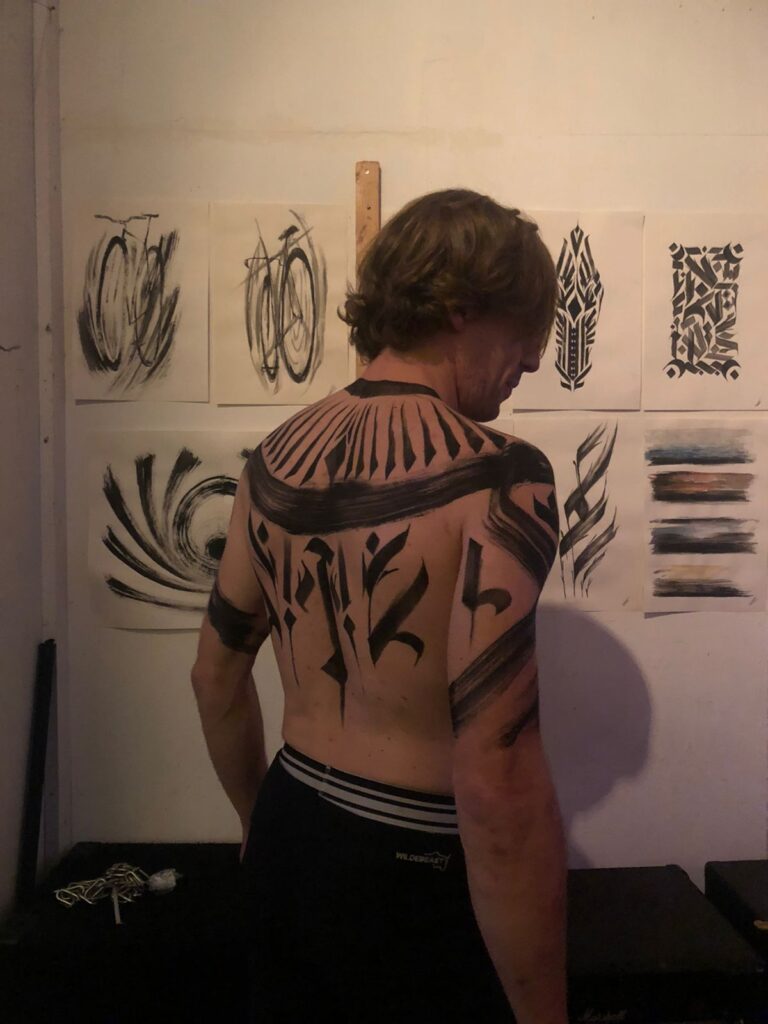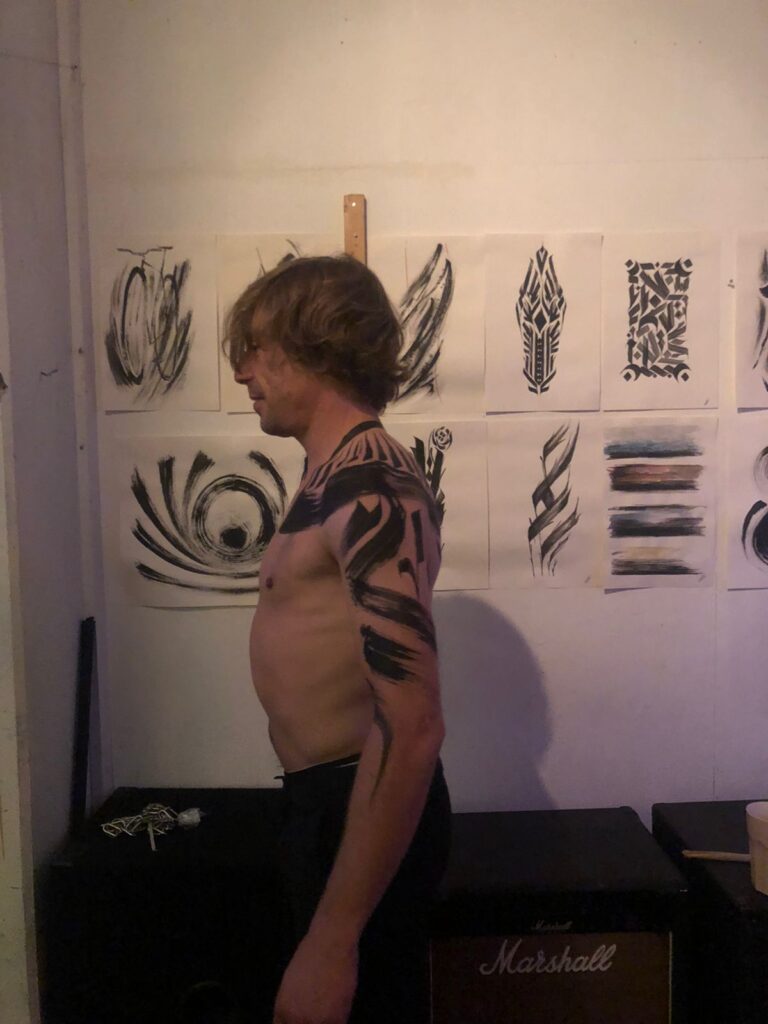Artist In Residence
Het torentje. We are looking for AIR; Artist In Residence! Are you an artist? Or do you love building? Whatever it may be… painting, singing, mediation, kung Fu..do you need a studio space to create? We are looking for AIR for a period of 3 months. The Torentje has a bed, shared kitchen& shared bathroom. DM for more info! air@rijkshemelvaart.com

_________________________________________________________________________________
Ahmad Mallah

De eerste helft van mijn residentie heb ik vooral geschilderd, getekend en mij voorbereid op de tentoonstelling “Nieuwe liefde” in Kunstliefde galerie in Utrecht en de tentoonstelling “Tot slot- Vrijheid” in Slot Zeist. Door het wonen en werken in een community in de natuur buiten de drukte van de stad ging ik met nieuwe technieken werken. Vanuit het gevoel van tevredenheid tijdens mijn verblijf op de Hemelvaart heb ik de gezichten met mijn vingers geschilderd omdat ik liefde wil geven aan mijn schilderijen i.p.v. werken met een schilders mes en de frustraties die ik de afgelopen jaren had.
De tweede helft van de residentie heb ik gewerkt aan een nieuw project “Rituals of the Siege”. Met deze installatie wilde ik afstand nemen van oude herinneringen van toen ik nog in Syrië leefde tijdens de oorlog. Een werk om los te laten. De installatie bestaat uit zes sculpturen, gemaakt van kippengaas en textiel en is een representatie van een begrafenis. Vijf familieleden zitten naast iemand die tijdens een bezetting is doodgeschoten om afscheid te nemen. Tijdens mijn eindpresentatie op 17 juni in het grote atelier op de Hemelvaart heb ik een performance gedaan met bloemen en deze zes figuren . De feedback van de kunstenaars van de Hemelvaart was belangrijk om mijn werk voort te zetten omdat ik twijfels had over het project. Ik zie het als werk in progress en wil in de toekomst deze installatie en performance uitbreiden.
Ik voel me herboren op de Hemelvaart, wat een fijne werkperiode! Ik zal het nooit vergeten.









_________________________________________________________________________________
Romain Lanneau

Decide yourself
Those giants in decay
Could it be a nest?
Or a Palais?
Some time ago, friends of mine came by to a free space. I invited them for a small gathering. Something very cosy and chill. A few drinks, some music and a lot of chit chat. I gave them a tour.
In the middle of the summer, in August, the sun was shining through the greens. We walked past the old building where the collective kitchen is located. There are big trees close to the brick walls, numbered like storage units. A big building of another era that has seen very different persons moving through. Built for a very ordered and clear-cut function, it was abandoned after a time. Uncovered by amateurs of the arts looking for an inspiring space to live. It stood for a new beginning.
Nature has its space around the building. It is a wild garden, full of flowers and trees swinging on its front yard. In France, where I come from, gardens are built differently. All the flowers are selected, closely chosen, so that everything forms lines and designed shapes. There is no space for chaos. Nature is fully tamed by the gardener. On the contrary, in this place nature has its own way. That’s a different mindset. Bowing towards the rules of the gardener or accepting the unexpected of the collective.
Back to my friends walking. They couldn’t have opened their eyes wider. They made their way through as if everything was strange and unexpected. It left quite an impression on me. I always admired the place, but I left most of this discovery’s look and feelings behind me. One of my friends, at some point, turned towards me and said: “I didn’t know something like this still existed!” On that day, I laughed. It seemed very innocent. In my mind, I thought, “but of course, you see it. It’s here and it hasn’t moved. Why would it?”
Because I am a gentle guy, I didn’t laugh. I looked away and showed them a circus standing nearby. Soon, we were all caught off guard by the sight of a pirate ship. At least, some parts of it, laying close to a canal. As if a crew of unruly seamen decided to dock their ship at the end of a canal, took their booze out, partied, and never left town.
Some time after the visit, a sentence from my friend was stuck in my head. “I didn’t know something like this still existed.” Did he know that something like this space existed before? What is something like this, exactly?
I could read in his expression that, despite having never walked in a similar place, he knew that it belonged. Here in this part of Amsterdam, but also here in our shared humanity. He was surprised to see it and happy, like when you find an unexpected flower growing on a patch of green grass. In the middle of the green, in perfect order, some vivid colours pop up to give you a sign that life can’t be tamed.
These places have meaning that people naturally and instinctively feel. This series of novels try to unravel why this might be the case, and why this matters.
My friend’s surprise about this space’s existence also showed something very real: there are only few of these spaces left. There were once many more.
Cities are evolving, as well as people’s mentalities. All around Europe, laws have been passed to forbid squatting. In the media, squatters are portrayed as criminals profiting from the property of hard-working people. Huge places are now hardly occupied. What was once squatted is now temporarily held or bought out. A transformation is taking plcae. That which was once unruled is now more chartered, restricted by municipalities or states.
Many times I heard talk about ghosts of the past. All neighbourhoods, gigantic buildings taken over and occupied for some time. I saw nostalgia on faces and in the chorus of voices. But I won’t take those pessimistic shadows for granted. History is made. I haven’t been there before. I have no space for regrets. To repeat the words of the Vrij Beton initiative: “The past was beautiful, but the world and the laws have changed. We have to accept that; change is inevitable and not in itself negative.”
Free places, breathing spaces, cultural centres, all of these have in common an autonomy. They are all what we usually know as a living place. It’s not a regular apartment or building. It breathes and changes with time. What is left and stays is an authenticity, a primal call that something different is happening. You can see it, feel it, taste it if you arrive for dinner.
It’s an invitation to be curious. Walk through it yourself, go check out what kind of autonomous spaces are being cultivated in your neighbourhood! See for example: www.amsterdamalternative.nl/places or www.radar.squat.net/fr/events/city/Amsterdam.
This book is a collection of voices. People I had the chance to meet and talk to. They shared with me glimpses of stories, both their own and their community’s.
There’s the story of a woman that dreamt to leave her village, to dance on the full moon and join the gypsy trail. I heard the deep voice of a man, with iron in his mouth and a large smile missing teeth. But in the same room there is also a cute ball of vivid colour, carried in her parents’ arms. The most joyful babe I had the chance to meet.
There are not only punks and anarchists talking with me. But there they are there. For sure!
You’ll find voices that travelled through Europe and beyond. But also, ones that were born here. In a place built by their kin, taken out of the cold. Their stories are diverse, fluid, and don’t stop in one place. They all have in common a shared understanding of what it is to live together, differently from what society considers normal. I don’t want to tell a romance, nor a fiction. I will write a collection using the stories I heard.
Share your thoughts with me: collectingvoices@protonmail.com
https://amsterdamalternative.nl/articles/10839/for-the-rijks-hemelvaart-dienst-a-palais-of-its-own
_________________________________________________________________________________
Alex Schulz
https://www.instagram.com/schulz_tattoo
Alex komt uit Brazilië en is schilder en tattoo artist. Hij studeert Japans en een abstracte manier van schilderen om een nieuwe stijl op te bouwen. Zijn wens is om mensen te laten zien hoe belangrijk kunst is, hoe kunst een mens kan veranderen en het leven kan verbeteren. De werken die hij maakt op canvas zou hij het liefst op mensen met littekens tatoeëren om deze te coveren. Met een vorm van beweging en expressie op het lichaam kan hij laten zien hoe deze kunst de mensen kan helpen. De afsluitende expo van zijn AIR residency bestond uit een live painting op een bezoeker om te laten zien wat zijn stijl is in zowel het schilderen als tatoeëren.






Alex is a painter and tattoo artist from Brazil. He studies Japanese and an abstract way of painting to build a new style. His wish is to show people how important art is, how art can change a person and improve life. He would prefer to tattoo the works he makes on people with scars to cover them. In this way he can show how art can help people with a form of movement and expression on the body. The final exhibition of his AIR residency consisted of a live painting on a young man to show his style in both painting and tattooing.
